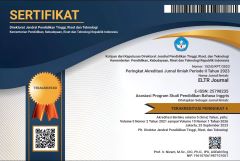THE INFLUENCE OF L1 ON L2 IN TRANSLATION: ERRORS MADE BY YOGYAKARTA STATE UNIVERSITY STUDENTS
Abstrak terlihat: 470 / PDF terunduh: 300DOI:
https://doi.org/10.37147/eltr.v4i2.64Keywords:
Cross-linguistic transfer, EFL learners, Error Analysis, Interlanguage Translation PrepositionsAbstract
This study investigates the errors made by Indonesian English learners within crosslinguistic interference between L1 and L2 (Indonesian and English). The data were gathered by making the respondents translate 6 Indonesian sentences which are commonly used during class presentation into proper English. Such task was aimed at investigating the interlingual preposition errors induced by the process of transfer between the target language (English) and the source language (Indonesian). The translation task was assigned in 22 October 2018 to 19 adult EFL learners of English Education Magister’s Program of Yogyakarta State University semester I. They were asked to translate the sentences from Indonesian into English within the allocated time. The task was conducted directtly by writing down the translation on a piece of paper. The data was then analyzed through Coder’s error analysis theory. The findings suggested that these particular English foreign language learners made the fewest errors on preposition omission – and more errors on wrong use and redundancy of prepositions.
Downloads
References
Cai, Yi-Wen & Lee, Hugo Yu-Hsiu. (2015). A Contrastive Analysis of Mandarin Chinese and Thai: Suggestions for Second Language Pronunciation. Theory and Practice in Language Studies: Academy Publication Journal, Vol. 5, No. 4, pp. 719-728.
Corder, S.P. (1973). Introducing Applied Linguistics. Middlesex, Penguin.
Corder, S.P. (1967). The Significance of Learner’s Errors. International Review of Applied Linguistics, 5, 161–170.
Delshad, S. (1980). Persian and English Prepositions Compared and Contrasted from a Pedagogical Point of View. Unpublished Doctoral Dissertation. University of Texas, USA.
Fries, Charles C. (1945). Teaching and Learning English as a Foreign Language. Ann Arbor: University of Michigan Press.
https://dictionary.cambridge.org/dictionary/english-indonesian/discuss.
Accessed on October 21, 2018 at 11. 10 a.m.
https://dictionary.cambridge.org/dictionary/english-indonesian/understand_1.
Accessed on October 21, 2018 at 11. 13 a.m.
https://dictionary.cambridge.org/dictionary/english-indonesian/present_2.
Accessed on October 21, 2018 at 11. 15 a.m.
https://dictionary.cambridge.org/dictionary/english-indonesian/tell.
Accessed on October 21, 2018 at 11. 17 a.m.
https://dictionary.cambridge.org/grammar/british-grammar/common-verbs/prefer. Accessed on October 21, 2018 at 11. 19 a.m.
https://dictionary.cambridge.org/dictionary/english-indonesian/similar.
Accessed on October 21, 2018 at 11. 20 a.m.
Koosha, M. & Jafarpour, A. A. (2006). Data-driven Learning and Teaching Collocation of Prepositions: The Case of Iranian EFL Adult Learners. Asian EFL Journal, 8(4), 192-209
Krzeszowski ,T. P. (1990). Contrasting Languages: The Scope of Contrastive Linguistics. Berlin: Mouton de Gruyter.
Lado, Robert (1957). Linguistics Across Cultures. Ann Arbor: The University of Michigan Press.
Lado, Robert (1957). Linguistics Across Cultures: Applied Linguistics for Language Teachers: University of Michigan Press
Richards, J. C. & Schmidt, R. (2002). Longman Dictionary of Language Teaching and Applied Linguistics (3rd Ed.). Malaysia: Pearson Education Limited.
Stern, H. H. (1983). Fundamental Concepts of Language Teaching. Oxford: Oxford University Press.
Yang, Man et al. (2017). An investigation of Cross-linguistic Transfer Between Chinese and English: A Meta-analysis. Asian-Pacific Journal of Second and Foreign Language Education, 2(15), pp. 1.
Downloads
Published
How to Cite
Issue
Section
License
Copyright (c) 2020 Laser Romios

This work is licensed under a Creative Commons Attribution-ShareAlike 4.0 International License.













